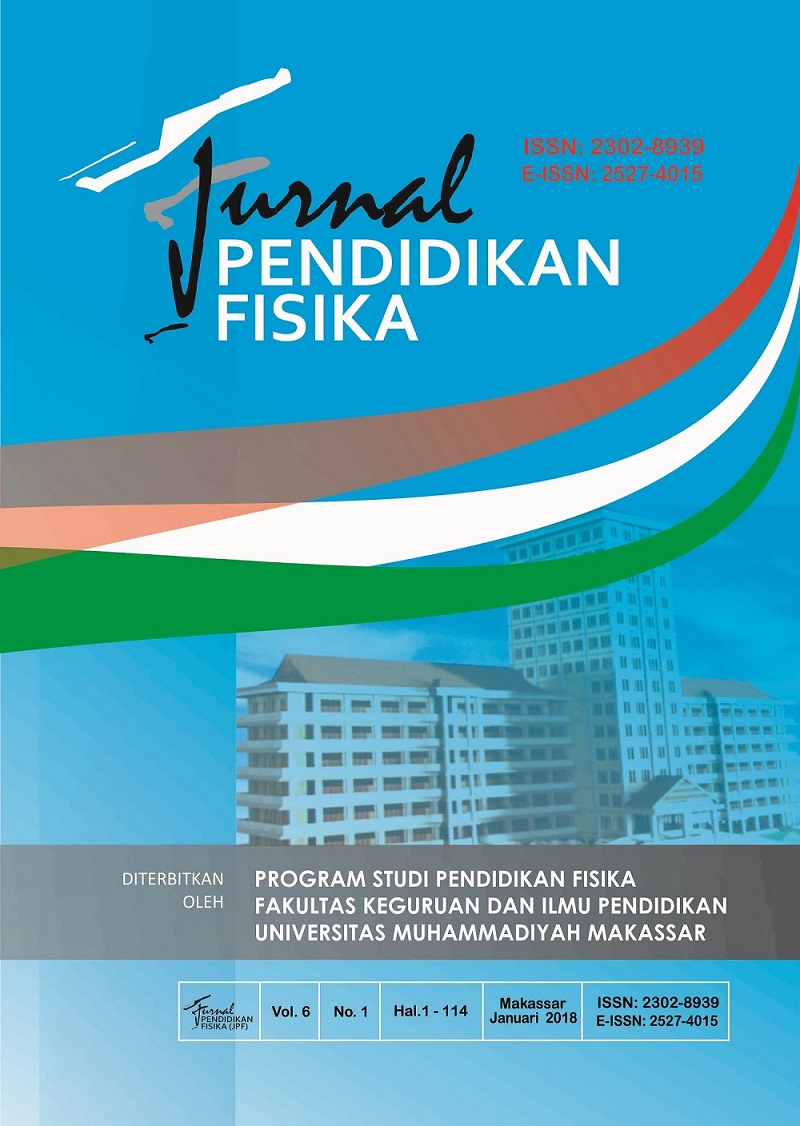Penerapan Model Pembelajaran Problem Solving untuk Meningkatkan Kemampuan Berpikir Kreatif Fisika Peserta Didik
DOI:
https://doi.org/10.26618/jpf.v6i1.1201Abstract
Penelitian ini bertujuan untuk menganalisis peningkatan kemampuan berpikir kreatif fisika peserta didik sebelum dan setelah diajar menggunakan model pembelajaran problem solving kelas XI SMA Negeri 4 Luwu. Jenis penelitian ini termasuk kategori jenis penelitian tindakan pra-eksperimen dengan desain penelitian yang digunakan adalah One-Group Pre Test-Post Test Design. Populasi pada penelitian ini adalah seluruh peserta didik kelas XI IPA1 SMA Negeri 4 Luwu yang terdiri dari 5 kelas. Berdasarkan pengacakan maka terpilihlah kelas XI IPA1 SMA Negeri 4 Luwu sebanyak 30 orang. Teknik pengumpulan data yang dipergunakan adalah tes kemampuan berpikir kreatif yang terdiri dari 10 item dalam bentuk soal essay yang terlebih dahulu telah di validasi oleh dua orang validator. Selanjutnya data yang diperoleh dari tes kemampuan berpikir kreatif dianalisis dengan menggunakan analisis deskriptif dan analisis N-gain. Hasil anailis deskriptif menunjukkan bahwa pada pretest kemampuan berpikir kreatif peserta didik memperoleh skor rata-rata sebesar 2,9 dan pada posttest skor rata-rata sebesar 25,6 dengan nilai Gain ternormalisasi 0,60 yang berada dalam kategori sedang. Berdasarkan hasil penelitian tersebut di atas, disimpulkan bahwa dapat meningkatkan kemampuan berpikir kreatif fisika peserta didik sebelum dan setelah diajar dengan menggunakan model pembelajaran problem solving dikelas XI SMA Negeri 4 Luwu Tahun ajaran 2017/2018.
Kata kunci: Model Pembelajaran problem solving, kemampuan berpikir kreatif
This study aims to analyze the improvement of creative thinking ability of physics learners before and after being taught using problem solving model of class XI SMA Negeri 4 Luwu. This type of research includes the type of pre-experimental action research with the research design used is One-Group Pre-Test-Post Test Design. The population in this study is all students of class XI IPA1 SMA Negeri 4 Luwu consisting of 5 classes. Based on the randomization then selected class XI IPA1 SMA Negeri 4 Luwu as many as 30 people. Data collection technique used is a creative thinking ability test consisting of 10 items in the form of essay questions that have been validated by two validators. Further data obtained from the creative thinking ability test were analyzed by using descriptive analysis and N-gain analysis. Descriptive anailis results show that in pretest creative thinking ability learners get average score of 2.9 and posttest on average score of 25.6 with normalized Gain value 0.60 which is in the category of being. Based on the results of the above study, it can be concluded that it can improve the ability of creative thinking of physics learners before and after being taught by using problem solving learning model class XI SMA Negeri 4 Luwu Year 2017/2018.
Keywords: Problem solving learning model, creative thinking ability
References
Mustiqon. 2012. Pengembangan Media dan Sumber Pembelajaran. Jakarta: Erlangga.
Siswono. 2007. Perjenjangan Kemampuan Berpikir Kreatif dan Identifikasi Tahap Berpikir Kreatif Siswa dalam Memecahkan dan Mengajukan Masalah fisika. Journal of physics Education Volume 01 Nomor 01 Maret 2012, hal 1-14.
Shaheen, R. 2010. Creativity an Education. Journal of School Education University of Birmingham UK, 1(3): 166-169. [3]Sani.2015.Model Pembelajaran.Jogjakarta: kata pena
Dwiyogo, W.D. 2016. Pembelajaran Visioner. Jakarta : PT Bumi Aksara.
Triantina. 2012. Teori belajar kontruktivisme (online) dalam http://riantinas. blogspot.co.id /2012 /06/teori-belajar-konstruktivisme.html. diakses pada tanggal 20 April 2017 pukul 08.09 wita.
Beaty, R. E. & Silvilia, P.J. 2012. Why Do Ideas Get More Creative Across Time? An Executive Interpretation of the Serial Order Effect in Divergent Thinking Task. American Journal of Psychological Association University of Nort Carolina at Greensboro, 6(4), 309-319.
Huda, M. 2016. Model-Model Pengajaran Dan Pembelajaran. Yogyakarta : Pustaka Pelajar
Sanjayanti, dkk. 2013. Model pembelajaran problem solving Bermuatan Pendidikan Karakter terhadap Keterampilan Berpikir Kreatif dan Sikap Ilmiah Ditinjau dari Motivasi Belajar. E-Journal Program Pascasarjana, Vol 3: Universitas Pendidikan Ganesha
Arikunto, S. 2006. Prosedur Penelitian. Jakarta: Rineka Cipta
Sugiyono. 2013. Statistika untuk Penelitian. Bandung: Alfabeta.
Maltzer, David E. 2003. Relationship Brtween Mathematics Preparation and Conseptual Learning
Sanjayanti, dkk. 2013. Model pembelajaran problem solving Bermuatan Pendidikan Karakter terhadap Keterampilan Berpikir Kreatif dan Sikap Ilmiah Ditinjau dari Motivasi Belajar. E-Journal Program Pascasarjana, Vol 3: Universitas Pendidikan Ganesha
Ristiasari, T. 2012. Model Pembelajaran Problem Solving dengan Mind Mapping terhadap Kemampuan Berpikir Kreatif Peserta didik.Unnes.J.physic.Educ. 1 (3). ISSN 2252-6579
Downloads
Published
Issue
Section
License
Copyright:
Authors who publish with this journal agree to the following terms:
1. Authors retain copyright and grant the journal right of first publication with the work simultaneously licensed under a Creative Commons Attribution-ShareAlike 4.0 International License that allows others to share the work with an acknowledgement of the work's authorship and initial publication in this journal.
2. Authors are able to enter into separate, additional contractual arrangements for the non-exclusive distribution of the journal's published version of the work (e.g., post it to an institutional repository or publish it in a book), with an acknowledgement of its initial publication in this journal.
3. Authors are permitted and encouraged to post their work online (e.g., in institutional repositories or on their website) prior to and during the submission process, as it can lead to productive exchanges, as well as earlier and greater citation of published work.
Licence:
Authors are free to:
1. Share: Copy and redistribute the material in any medium or format
2. Adapt: Remix, transform, and build upon the material for any purpose, even commercially.
The licensor cannot revoke these freedoms as long as the authors follow the license terms, which include the following:
1. Attribution: You must give appropriate credit, provide a link to the license, and indicate if changes were made. You may do so in any reasonable manner, but not in any way that suggests the licensor endorses you or your use.
2. ShareAlike: If you remix, transform, or build upon the material, you must distribute your contributions under the same license as the original.
3. No additional restrictions: You may not apply legal terms or technological measures that legally restrict others from doing anything the license permits.
Jurnal Pendidikan Fisika is licensed under a Creative Commons Attribution-ShareAlike 4.0 International License.

